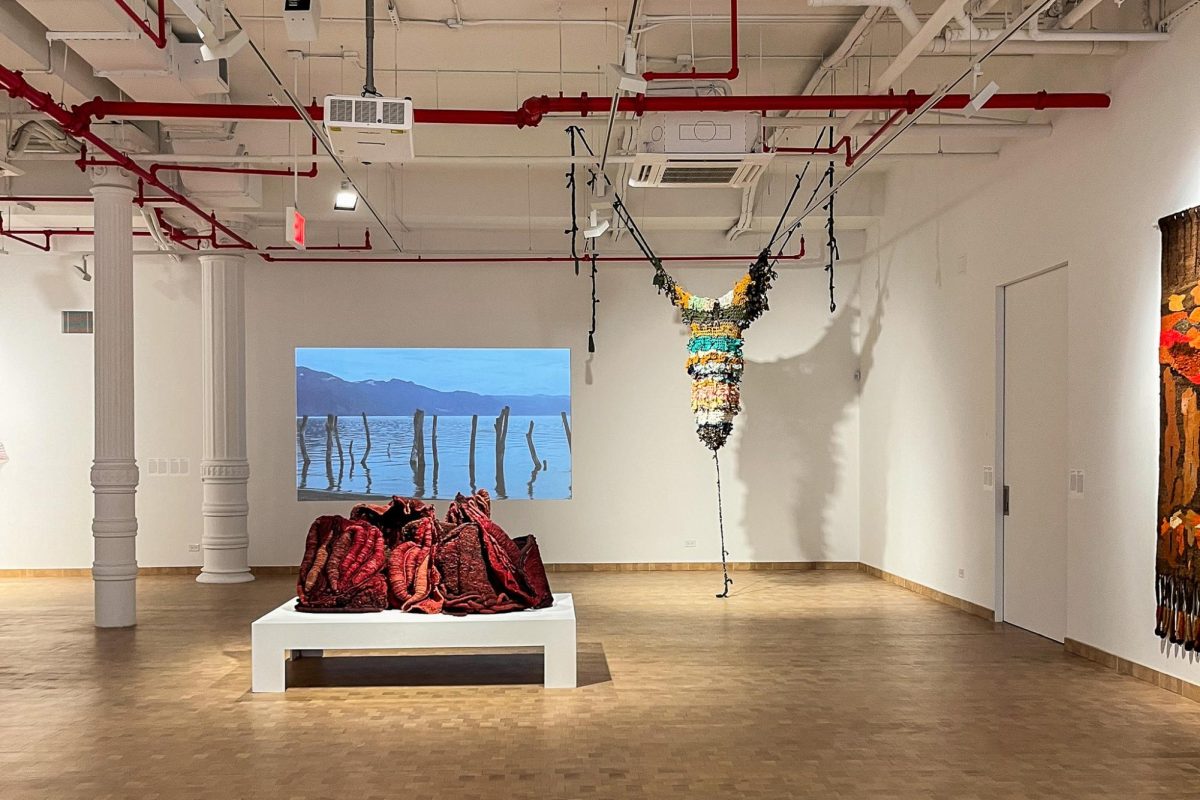“The slow turn of the spinning wheel is what makes the thread perfect,” reads written narration from Elvira Espejo Ayca’s to a 17-minute-long video where she spins, winds and combs through cotton. “The quick spin of the spinning wheel is what makes the thread strong. Feeling things is what makes you a teacher.”
The video installation “The Thinking of Our Philosophies” — an homage to Bolivian weavers and spinners — is currently on display at the Institute for Studies on Latin American Art as part of the exhibition “Threads to the South.”
“Threads to the South,” curated by Anna Burckhardt Pérez, is being exhibited at ISLAA. The exhibition features various mediums of works by artists from 10 Latin American countries, among them Feliciano Centurión, Gracia Cutuli, Jorge Eielson, Lidia Lisbôa and Cecilia Vicuña. The curation also showcases the symbolic relationship between the medium of fiber with memory, longing, territory and resistance.
The exhibition is divided into two floors, one dedicated to nativity and identity and the second to resistance and rebellion. Each part of the space takes its own tangible form, from canvases hanging on the white walls to large crocheted cylindrical pieces hanging from the ceiling.
“I Miss Your Color Paraguay” — embroidered in Spanish in one of Feliciano Centurión’s quilted blankets — displays red and white squares in front of a gray background and outlined by a red lining. At the focal point is a red circular fabric with the titular words embroidered around a pink flower. Through the piece, Centurión yearns for his native home, Paraguay, from where he and his family were forced to escape during the dictatorship of Alfredo Stroessner in the 1950s.
By 1974, Centurión moved to Buenos Aires, Argentina, where he had more freedom to explore his queerness and artistry. He was drawn to “frazadas,” large, mass-produced synthetic blankets native to his new home. In Paraguay, Centurión had been raised by his grandmother and mother who’d taught him from a young age to sew and crochet.
Since then, he had always been drawn to traditional Paraguayan craft practices historically associated with women, and incorporated these craft-based elements into his artwork. Centurión’s art, reminiscent of handmade familial items, acts as a reminder of home.
Like Centurión, Lisbôa uses work to explore her identity as well. She explores womanhood in her crocheted, untitled piece from the series “Breasts That Nursed the World.” Four threaded strings hang from the ceiling and meet at its center to form a funnel-like cascade of different colored crocheted patterns. Green, gray, blue, white and peach-colored layers flow down onto a black braided string that meets the floor.
Through this piece Lisboâ is claiming her own female body while also employing the crochet techniques she learned as a child from family members. She opens the floor for a conversation as she threads her childhood self and with her current self as a mother. Lisbôa’s defiance serves as an inspirational reminder that while our bodies and roles in life may change over time, our identity still remains intact and everlasting.
Cutuli explores creativity through the confinements of sexism in the artistic landscape. In 1960s Argentina, galleries were more or less exclusively welcoming toward male artists, limiting the typical mediums most female artists had access to at the time, including painting on canvas. As a response, Cutuli created her artworks with wool.
Cutuli’s “Vendimia” is a mix of red shades, from dark purples to vibrant reds to rose pinks. In an accordion-like fashion, the multicolored strings hang from the piece, ascending from longer to shorter lengths. She employs weaving techniques native to her home, with the use of native wools and cottons woven using a floor-based loom.
Determined to create a space where her art and others would be welcomed, Cutuli founded Galería El Sol in Buenos Aires, the first gallery in the Americas exclusively dedicated to textile art. Despite the limitations she faced, Cutuli inspirationally resisted the sexist ideals cemented in the art industry and fought for her art to be seen alongside those of many other artists. It is invigorating to see that after so much effort and determination to defy the sexist artistic norms of her time, Cutuli’s work is exhibited alongside many other female artists in ISLAA.
“Threads to the South” narrates a story of rebellion and triumph, but also of loss and grief. The exhibition poignantly explores identity through textile art and does so successfully. In Latin America, thread provides a guide from our beginnings to our endings and lays the foundation for the histories that we embody. This exhibit provided me a guide to thread back to my childhoods as I yearned for my places of origin.
“Threads to the South” will be displayed at the ISLAA until July 27.
Contact Diana C. Sánchez González at [email protected].

























































































































































